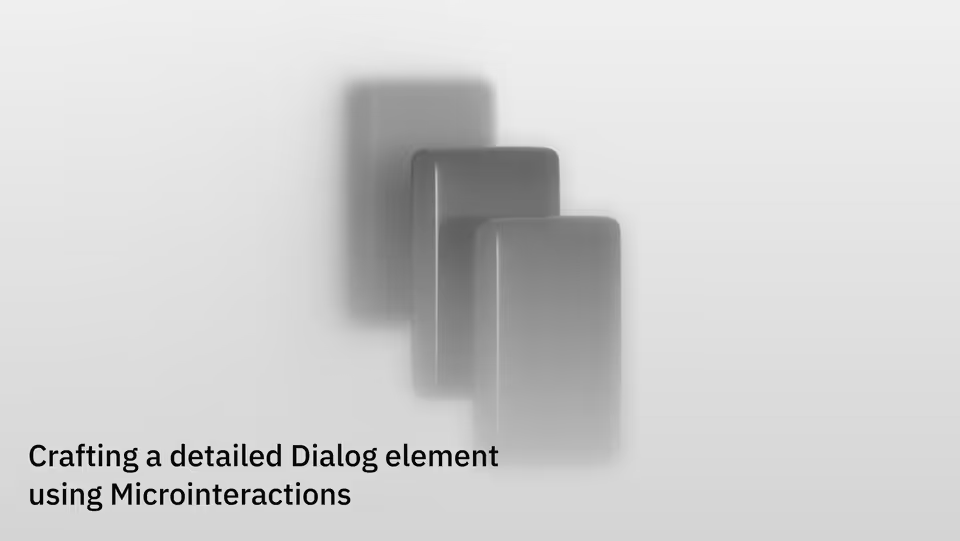In this article and the steps that follow, we’ll create a detailed dialog modal using various CSS animation and transition properties to create more engaging microinteractions.
The basics
In its most basic form, triggering a dialog necessitates only two elements: a button to open the dialog and the dialog itself. The button is linked to the dialog by using the showModal() method, which is a built-in method of the dialog element.
<div id="app">
<div id="content">
<button>Open Dialog</button>
<dialog>
<p>Hello World</p>
</dialog>
</div>
</div>const button = document.querySelector('button');
const dialog = document.querySelector('dialog');
button.addEventListener('click', () => dialog.showModal());Styling the dialog
To make our dialog modal pop a little more, we’ll remove the default border, add a border radius, and apply a drop shadow. Otherwise, you can treat your dialog element like any other element and style it accordingly.
dialog {
border: unset;
border-radius: 0.375rem;
filter: drop-shadow(0 0.75rem 0.75rem #00000020);
}Styling the backdrop
The backdrop is the standard overlay that appears behind the dialog. You’ll also encounter it when working with popovers. We can style it using the ::backdrop pseudo-element. In this example, we’ll set the background color to a semi-transparent black.
dialog::backdrop {
background-color: #00000020;
}Adding microinteractions
Now we’ve added a simple but very plain implementation of a dialog modal. To spice things up, we add the aforementioned microinteractions using CSS animation and transition properties to give the dialog a more engaging feel and some depth.
Setting root variables
Define a CSS variable for the duration of the animation and set it to 150ms or a value of your choice. If the user prefers reduced motion, respect their preference and set the duration to a less eye-straining value or 0ms.
:root {
--animation-duration: 150ms;
@media (prefers-reduced-motion) {
--animation-duration: 0ms;
}
}Defining the animation
For this example, we’ll use one of the simplest animations available and fade in the dialog. We’ll define a keyframe animation called fade-in that will fade the dialog in from 0% to 100% opacity.
@keyframes fade-in {
0% {
opacity: 0;
}
100% {
opactiy: 1;
}
}dialog {
animation: fade-in var(--animation-duration) ease-out both;
&::backdrop {
animation: fade-in var(--animation-duration) ease-out both;
}
}Adding depth with transformations
To give the dialog a sense of depth, we’ll apply a perspective transformation to the #app element. This will bring the dialog into the foreground, while the #app element will fade into the background and its #content will become blurred.
Note, that we’ve employed @media (prefers-reduced-motion: no-preference) to only apply the perspective change, if the user has not set their preference to reduced motion.body {
background: #eee;
&:has(dialog[open]) {
overflow: hidden;
@media (prefers-reduced-motion: no-preference) {
#app {
border-radius: 0.75rem;
filter: drop-shadow(0 0.75rem 0.75rem #00000020);
overflow: hidden;
transform: perspective(100vw) translateZ(-3rem);
}
}
#content {
filter: blur(0.125rem);
}
}
}Applying transitions
All that’s left now is to apply the appropriate transition properties to the #app and #content elements to animate the transformation and filter properties accordingly. To distinguish #app as a layer, consider also using a dimmed background color for the <body>.
#app,
#content {
transition-property: transform, filter, border-radius;
transition-duration: var(--animation-duration);
transition-timing-function: ease-out;
}#app {
background: #fff;
}Result
And that’s it 🎉 You’ve just implemented a nicely animated dialog modal into your page, respecting user preferences and using standard and common techniques and tools.
TL;DR
Learn how to create a detailed dialog modal using microinteractions. We’ll cover the basics, styling the dialog, adding microinteractions, and applying transitions properly.

